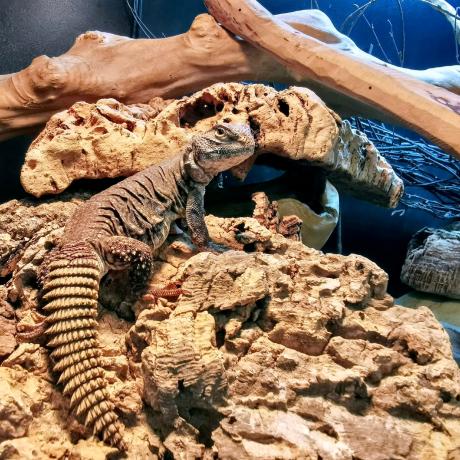

The Mali Uromastyx is as the name suggests is from Mali and southern Algeria. They inhabit areas with fine sand and very hot temperatures.
This is a medium-sized Uromastyx and typical in appearance with a round head and spiky tail. Their colour can vary from light to dark grey with mottled spotting on the back. Males tend to have some colour along their back when mature which is generally yellow.
This species occurs in Mali and Southern Algeria in the hot sandy deserts.
An adult Mali Uromastyx should be housed in a 48x24x24inch vivarium. Personally, we would say to house a younger animal in the same sized enclosure due to the high temperatures required, this helps with the temperature gradient.
The basking area should reach 50-55C (122-131F), the remaining vivarium temperature range between 30-45C (86-113F). This species requires a big drop in temperature at night, this needs to drop down to 20-22C (68-71.5F). All lamps must be connected to thermostats, the use of a 'High Range' for the basking bulb and a pulse or mat stat for the ceramic bulb as this will be required to help maintain the nighttime temperature. All basking bulbs and ceramic heaters should be protected with a guard to prevent any accidental burns. Uromastyxs require a zone 4 on the Ferguson scale, therefore a T5 14% UVB bulb is recommended.
Mali Uromastyxs prefer deep substrate, ideally with burrows that are slightly humid. We always recommend a number of shelters, however, in the wild, their habitat is mainly open sandy areas. Lightly mist under one hide every few days to maintain a low humidity level.
Feed baby and young Uromastyx every day, adults every other day, they will feed on a range of leafy greens and seeds;
Avoid cabbage vegetable such as broccoli, brussels sprouts and also spinach, these foods may interfere with calcium intake. Babies and juveniles will take the odd insect, offer a few each week. Add a calcium supplement with a small amount of Vitamin D to their food, babies are fast growing and require this more than adults.
Adult Uromastyx do not require a water dish, they seldom or never drink from open water. Babies do need more water, once a week place them in a shallow water dish to hydrate by drinking and soaking.